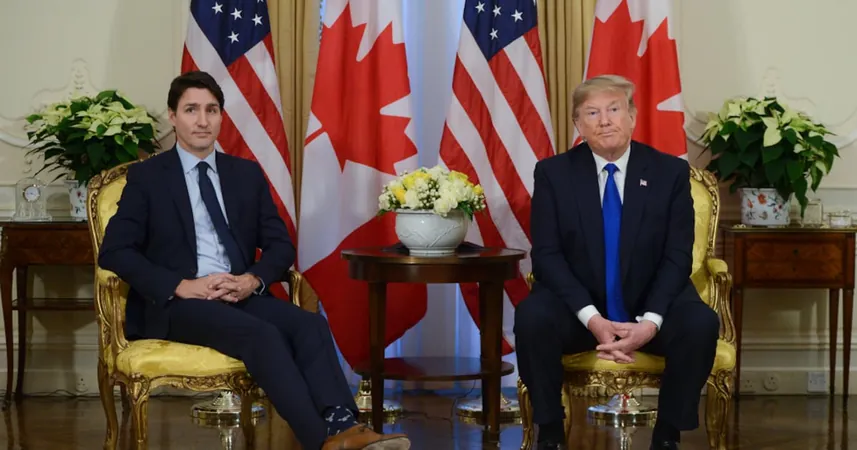
Trump’s Return to Power: A Looming Economic Storm for Canada?
2024-11-06
Author: Charlotte
Trump’s Return to Power: A Looming Economic Storm for Canada?
As Canadians digest the shocking news of Donald Trump's return to the White House, alarm bells are ringing across the nation regarding the potential impacts on the Canadian economy and the critical Canada-U.S. trade relationship. Trump's combative protectionist policies, including a proposed universal 10% tariff on all imports from Canada, have left many Canadian business leaders in a state of unease.
A recent report from the Canadian Chamber of Commerce highlighted the dire consequences of these tariffs, estimating a staggering $30 billion annual cost to the Canadian economy. Alarmingly, over 77% of Canada's exports are directed to the United States, making the outcomes of such tariffs especially concerning.
"The manufacturing sector could be one of the hardest hit, as it is the most trade-exposed industry in Canada," warned Dennis Darby, president and CEO of Canadian Manufacturers and Exporters. Darby emphasized the importance of maintaining trade relations for the benefit of consumers on both sides of the border, stating, "We must be able to trade goods, materials, and ingredients as we have under existing trade agreements."
Concerns extend beyond Canada’s borders, as American economists predict that Trump's tariffs could spark inflation in the U.S. and even trigger a recession. In turn, this economic turbulence could send shockwaves throughout Canada. Darby cautioned, "Inflationary impacts will ultimately burden consumers, as tariffs tend to raise costs and prices."
The 2022 trade figures reveal stark realities: approximately $960.9 billion in trade flowed between Canada and the U.S., underscoring the interdependence of the two economies. A recent analysis from TD economist Marc Ercolao indicated that if Trump’s tariff plan is fully implemented, Canada could see a near 5% reduction in export volumes to the U.S. by early 2027.
The prospect of retaliatory measures from Canada could also complicate matters, raising costs for domestic producers and resulting in lower import volumes. According to Ercolao, while slowing import activity might mitigate some negative impacts on GDP, it also threatens an extended period of economic stagnation through 2025 and 2026.
However, not all hope is lost. Drawing on lessons from Trump’s first term, where many threatened tariffs on Canada did not materialize, Ercolao points out that localized impacts of past tariffs, such as those on steel and aluminum, were less severe than initially feared.
Since the Canada-United States-Mexico Agreement (CUSMA) came into effect in 2020, bilateral trade has significantly surged—by an impressive 46%. Yet with the agreement up for review in 2026, the stakes are high. Candace Laing, president and CEO of the Canadian Chamber of Commerce, stressed the need for effective collaboration with the Trump administration to solidify and enhance this vital economic partnership.
Several provinces in Canada heavily rely on trade with the U.S. for economic stability. For example, New Brunswick’s economy is 62% reliant on U.S. trade, while Manitoba, Alberta, Ontario, and Quebec follow closely behind.
Interestingly, many U.S. states share this economic interdependence, with Montana’s economy deriving 16% of its revenue from Canadian trade, closely followed by Michigan and Illinois.
With a staggering $3.6 billion in daily trade, Canada and the United States stand as their closest economic allies. Laing aptly noted, "The secure and efficient flow of goods and people across our border is essential for both economies." Urging both nations to resist arbitrary tariffs and trade barriers, she highlighted how fostering strong cross-border supply chains could enhance shared economic security while ensuring consumers on both sides are not left paying the price.
As Trump prepares to take the helm once again, all eyes are now on the unfolding trade dynamics—and whether Canada can navigate this tumultuous new chapter successfully.









 Brasil (PT)
Brasil (PT)
 Canada (EN)
Canada (EN)
 Chile (ES)
Chile (ES)
 España (ES)
España (ES)
 France (FR)
France (FR)
 Hong Kong (EN)
Hong Kong (EN)
 Italia (IT)
Italia (IT)
 日本 (JA)
日本 (JA)
 Magyarország (HU)
Magyarország (HU)
 Norge (NO)
Norge (NO)
 Polska (PL)
Polska (PL)
 Schweiz (DE)
Schweiz (DE)
 Singapore (EN)
Singapore (EN)
 Sverige (SV)
Sverige (SV)
 Suomi (FI)
Suomi (FI)
 Türkiye (TR)
Türkiye (TR)